At its 2021 Fall meeting in late October the Audubon Foundation of Texas (AFT) awarded collaborative grants to six Texas chapters to support local conservation projects. These grants were made possible by funds raised by AFT’s participation in EarthShare Texas workplace campaigns.
- Travis Audubon: Blair Woods Bird Blind and Drip Water Feature
- Houston Audubon: Bolivar Peninsula Webcam Replacement
- Audubon Dallas: Blackland Prairie Restoration at Cedar Ridge
- Bexar Audubon: Bird City Promotional Activities
- Tyler Audubon: Bird Diversity Study of University of Texas at Tyler
- Rio Brazos Audubon Society: Nocturnal Flight Calls Monitoring Station
Travis Audubon: Blair Woods Bird Blind and Drip Water Feature
Awarded $1000
Travis Audubon aims to enhance accessibility to nature and promote birding interest through the construction of a bird blind and drip at Blair Woods. This revitalization project has attracted more native bird species to the area each year. Birding can be challenging for inexperienced or mobility-impaired individuals due to dense canopies and the learning curve of using binoculars. The running water at the blind attracts birds, facilitating reliable sightings. This grant is to partially fund the construction of the bird blind. The goal is for 80% of Blair Woods Preserve visitors to utilize and enjoy the bird blind, as monitored by trail counters.
Update: 1/1/2023
Water feature is finished. Bird activity is being monitored before deciding location and design of bird blind.
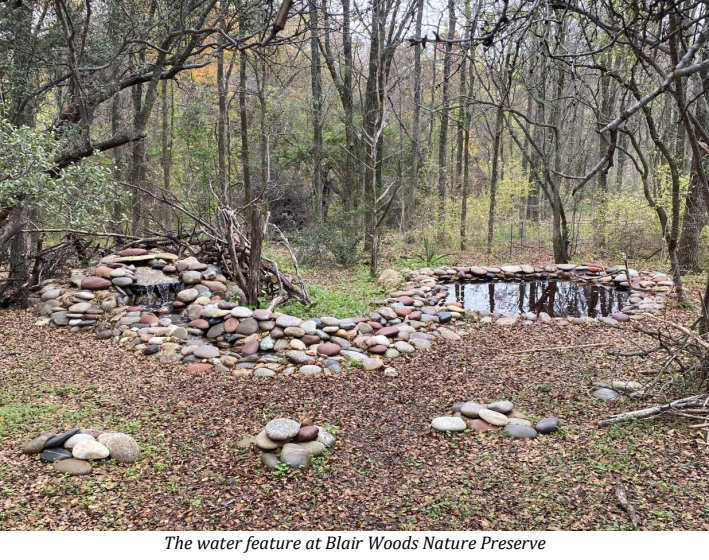
————————————————————————————————————-
Houston Audubon: Bolivar Peninsula Webcam Replacement
Awarded $900: Completed
The live webcam at Houston Audubon’s Bolivar Flats Shorebird Sanctuary, which showcases over 20 species of shorebirds in their resting and nesting habitat, was destroyed by a lightning storm in August 2021. This grant provided funds to purchase a new camera and restore the popular webcam, which receives approximately 12,000 views per year. The webcam serves as a powerful outreach tool, educating the public about the breeding and nesting behaviors of various shorebird species and assisting emergency response teams in tracking storm surge. It also enables Houston Audubon staff to monitor activity remotely. Through a partnership with the Bolivar Peninsula Tourism and Visitors Center, the webcam provides online visitors with an immersive experience of the wetlands and wildlife on Bolivar Peninsula, offering unmatched access and stunning views through its advanced features. The camera is mounted on the property of a long-time Houston Audubon member, providing a unique vantage point to observe the birding spectacle at any time. Bolivar Flats, encompassing salt marsh, mud flats, and beach, is designated as a Globally Important Bird Area and an International site within the Western Hemisphere Shorebird Reserve Network. Houston Audubon manages Bolivar Flats, along with 13 other sanctuaries in the region.
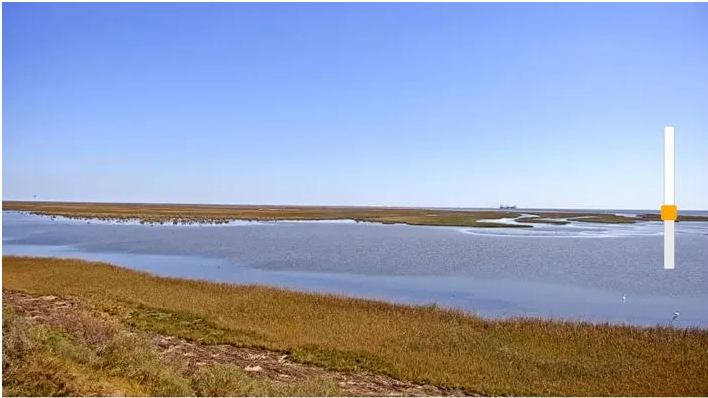
Try it yourself — Link
———————————————————————————————————–
Audubon Dallas: Blackland Prairie Restoration at Cedar Ridge
Awarded $1000
Audubon Dallas manages the 620-acre Cedar Ridge Preserve in southern Dallas County, where the Blackland Prairie meets the limestone escarpment. The preserve consists of open and wooded areas, streams, creeks, and a pond, supporting diverse wildlife, including the endangered Black-capped Vireo. Restoration efforts focus on native prairie restoration, aiming to enhance plant diversity and attract more resident and migratory birds to the area.
In November 2022, a successful Prairie Planting Day, partially funded by this grant, was organized with the participation of 55 volunteers. The event began with a brief orientation and allowed time for social interaction among the diverse group. Over the course of three hours, the volunteers planted an impressive total of nearly 425 plants, comprising 12 species of forb and 6 species of grass. These plantings took place across three different prairies within the Preserve.
The availability of necessary equipment, materials, and expertise from previous prairie plantings was made possible through the support of the Audubon Foundation of Texas. Cedar Ridge Preserve played a crucial role in propagating many of the plants from locally collected seeds. Additionally, around 50 plants were purchased from a trusted local grower, contributing to the overall variety and success of the project.
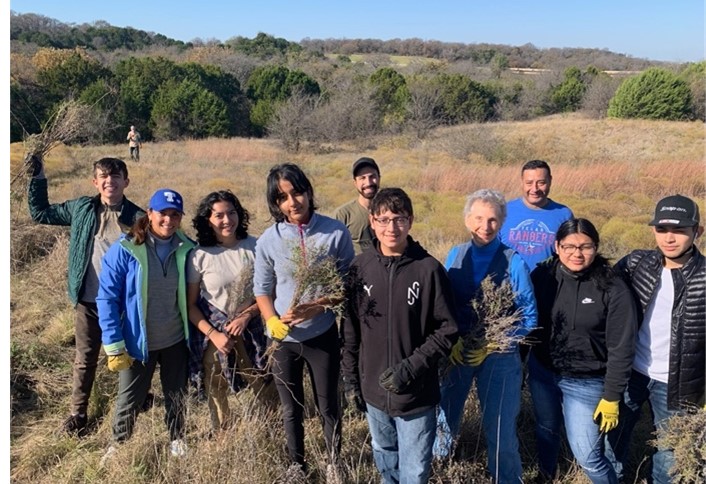
——————————————————————————————————–
Bexar Audubon: Bird City Promotional Activities
Awarded $1000
Bexar Audubon is raising funds to support San Antonio’s Bird City Texas certification and its goals for habitat enhancement, native plant increase, threat reduction, public awareness, and environmental stewardship over the next three years. The Bexar Audubon Society supports these efforts and will apply the grant funding in addition to funding from other sources. The funding needs include $100 for booth expenses at community engagement events, utilizing 5500 brochures from the existing stock, acquiring a $250 webcam for monitoring a bird rookery in Brackenridge Park as part of community education, $1,000 for printing and purchasing outreach brochures on various topics, $1,500 for volunteer T-shirts recognizing their work on Bird City Texas-San Antonio projects, and $1,000 for production costs of educational videos for homeowners on bird care. These funds are crucial for effectively fulfilling the BCTX certification requirements and contributing to bird conservation efforts in San Antonio. By supporting community engagement, education, and outreach, the Bexar Audubon Society aims to create a positive impact on bird populations and promote a greater understanding of the importance of bird conservation in the local community.
———————————————————————————————————
Tyler Audubon: Bird Diversity Study of University of Texas at Tyler
Awarded $1000: Completed
This grant funded the acquisition of 20 bird nesting boxes, an industrial endoscope, four trail cameras, and audio equipment for bird monitoring at The University of Texas at Tyler. The study had three main objectives: 1) conduct a baseline study of bird diversity on the campus, 2) monitor bird diversity and evaluate the effectiveness of the nesting boxes, and 3) address conservation concerns and develop management strategies for the campus.
The research began in March 2022, with surveys conducted by a team consisting of faculty, graduate students, undergraduates, and members of the Tyler Audubon. Diurnal and monthly nocturnal avian point counts were performed at ten designated sites across the campus, aimed at understanding the impact of human activity on bird populations. A total of 69 bird species were observed between April and December 2022, with Eastern Bluebirds being the primary occupants of the nesting boxes.
The bird boxes were installed based on guidelines from the North American Bluebird Society, with proper spacing and monitoring protocols implemented. An industrial endoscope allowed for non-intrusive observation of nest development, while trail cameras captured passing wildlife, including nocturnal species. The project involved collaboration with undergraduate and graduate students, as well as the local Audubon Society.
The grant funds were used to support student researchers, and future plans include the continuation of bird research and increased engagement with the birding community. Overall, the study aimed to establish a baseline of bird diversity, assess the impact of anthropogenic factors, and contribute to conservation efforts on the university campus.
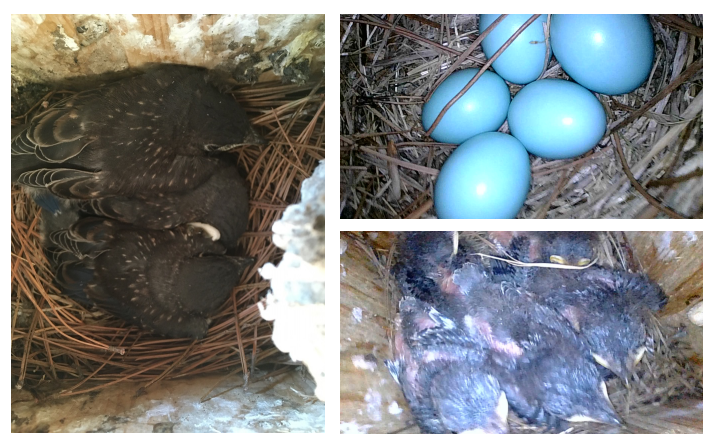
————————————————————————————————–
Rio Brazos Audubon Society: Nocturnal Flight Calls Monitoring Station
Awarded $750
The Rio Brazos Audubon Society (RBAS) was funded to implement a seasonal monitoring station in Brazos County, Texas, near College Station, to study nocturnal avian migration using Nocturnal Flight Calls (NFCs). While NFC monitoring is common in the eastern United States, it is less studied in Texas. The project aims to collect acoustic data on avian migration, provide volunteer and outreach opportunities, and disseminate educational resources through project data.
In 2022, a Zoom digital audio recorder was purchased with a grant, and it was set up in a local natural area called ENRTA during the Spring migration for several nights. The recorder was placed in a large flowerpot with bubble-wrap padding after consulting with an expert. The sound files captured were manually inspected by volunteers, but the results were mixed, with better pickup of certain bird calls than others due to the recorder’s microphone not being sufficiently directional and sensitive.
For the 2023 Spring migration season, changes were made using the remaining grant funds. A specialized directional microphone, the Old Bird 21C, was purchased and positioned about 15 feet above the ground on a shipping container to minimize background noise.
To assist in extracting and identifying flight calls, the Vesper software was downloaded and tested. This software allows for the automatic detection and extraction of potential bird sounds and aids in identification.
Efforts are being made to acquire a donated PC so that volunteers will have direct access to extract migration call data and prepare summaries
The project outcomes will include recording the total detection of each species during recorder operation. These findings, along with project details and discussions on migratory ecology, will be shared through the RBAS website, social media channels, and email list-serv throughout each migration season, reaching an estimated 800-1000 people.
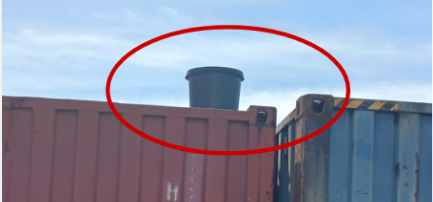
————————————————————————————————–